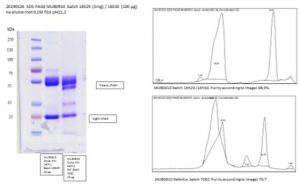MUB0910P – improved purity enhances data quality
Our mouse anti-integrin alpha 5 antibody (CD49e), MUB0910P, is just one of many high-quality integrin antibodies within our portfolio. Produced by fusing mouse myeloma cells with spleen cells from BALB/C mice immunized with U937 histiocytic lymphoma cells, this clone (NKI-SAM-1) has been widely literature cited for integrin research. Now, as a result of comprehensive re-optimization of our MUB0910P purification process, we can offer researchers a product of superior quality. At approximately 98% purity, MUB0910P is suitable for flow cytometry, immunocytochemistry, immunoprecipitation, and immunohistochemistry with frozen tissue.
Integrin alpha 5
Integrins are a diverse family of transmembrane proteins, each consisting of an alpha subunit and a beta subunit. There are at least 18 types of alpha subunit and 8 types of beta subunit in humans, which associate to form at least 24 different integrins. These are named according to their subunit composition, for example integrin alpha 5/beta 1. The alpha 5 chain, encoded by the human ITGA5 gene, belongs to the integrin alpha subunit family and is also referred to as CD49e, VLA-5 alpha subunit, or fibronectin receptor alpha.
Integrin alpha 5/beta 1 (also known as very late antigen complex, or VLA-5) is a receptor for fibronectin. It is expressed by cells including thymocytes, T-cells, monocytes, platelets, early and activated B-cells, endothelial cells and epithelial cells, and functions as an adhesion molecule in addition to regulating cell survival and apoptosis. The alpha 5 chain is largely responsible for the high degree of fibronectin binding specificity.
MUB0910P
Each vial of MUB0910P is formulated as a 1mg/mL solution in PBS containing 0.09% sodium azide. Although epitope mapping has not been performed, the antibody has been shown to react strongly with monocytes, and weakly with granulocytes, platelets and T-lymphocytes. The utility of this clone (NKI-SAM-1) is well referenced in the literature, for example to determine VLA-5 expression in monocyte-derived dendritic cells and B-cell precursors by flow cytometric analysis.
Using an enhanced purification strategy for MUB0910P, we have produced an anti-integrin alpha 5 antibody of approximately 98% purity. This represents a significant improvement on a previous antibody batch of around 80% purity, as shown in our Imagel analysis. This demonstrates our ongoing commitment to support integrin research and highlights one of the many ways in which we are continually improving our product range.

The image scans are done by Image J
References
Giovino MA, Wang H, Sykes M, Yang YG. Role of VLA-4 and VLA-5 in ex vivo maintenance of human and pig hematopoiesis in human stroma-supported long-term cultures. Exp Hematol. 2005; 33: 363-70.
